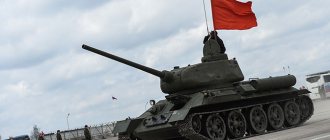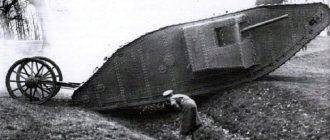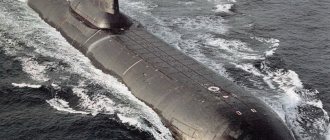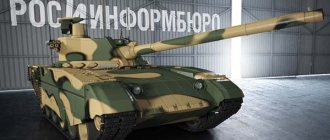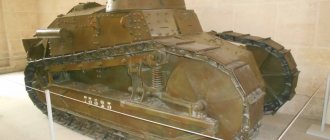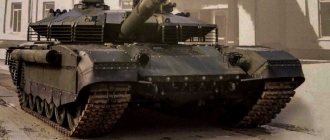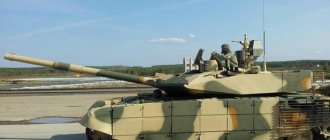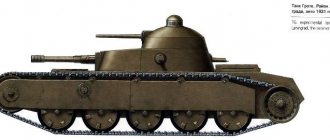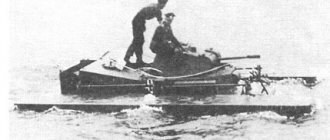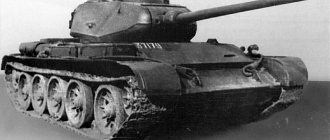Performance characteristics (TTX)
general information
- Classification - main battle tank;
- Combat weight - 42 tons;
- The layout is classic;
- Crew – 3 people;
- Years of operation: since 1976;
- The number of units produced is more than 10 thousand pieces.
Dimensions
- Case length – 6982 mm;
- Length with gun forward - 9654 mm;
- Case width – 3525 mm;
- Height – 2193 mm;
- Ground clearance – 450 mm.
Booking
- Type of armor - rolled and cast steel and combined, projectile-resistant;
- Dynamic protection - Contact-1, Contact-5.
Armament
- Caliber and brand of gun - 125 mm 2A46-1;
- Gun type: smoothbore gun;
- Barrel length - 48 calibers;
- Gun ammunition - 38;
- HV angles: -5…+14°;
- Firing range – 3.7-5 km;
- Sights - optical sight-rangefinder TPD-2-49, periscope night sight TPN-3-49;
- Machine guns - 1 × 12.7 mm NSVT, 1 × 7.62 mm PKT.
Mobility
- Engine type and brand – GTD-1000T air-cooled gas turbine;
- Engine power – 1000 hp;
- Highway speed – 65 km/h;
- Speed over rough terrain – 50 km/h;
- Cruising range on the highway – 350 km;
- Cruising range over rough terrain – 250 km;
- Suspension type: individual torsion bar;
- Specific ground pressure – 0.84 kg/cm²;
- Climbability – 32 degrees;
- The wall to be overcome is 1 m;
- The ditch to be overcome is 2.85 m;
- Fordability - 1.2 m.
T-80 modifications
- T-80A, developed in the mid-1970s;
- T-80U - modification with various technical improvements;
- T-80UK – command version of the tank with additional radio stations, navigation system and sensors;
- T-80UE - modification designed in 1995 for the Greek tender;
- T-80UM1 "Bars", a relatively new modification (1997). It was distinguished by an improved engine, air conditioning system, a new gun and installed complexes and systems;
- T-80B, entered service in 1978;
- T-80UD, "Birch", with an anti-aircraft machine gun mount and a diesel engine;
There were also a number of Ukrainian modernizations of this tank.
Use in combat
- On October 4, 1993, it was T-80UD tanks that fired at the building of the Supreme Council of the Russian Federation during the White House Shooting;
- In 1994-1996, T-80s took part in the First Chechen War, for example, during the assault on Grozny;
- At the beginning of 2015, several T-80BVs were used by government forces in the armed conflict in Yemen. One T-80 was destroyed and another was captured by the rebels;
- In 2015, in eastern Ukraine, a zone of armed conflict, many unmarked T-80s were reported in rebel territory.
Memory of a tank
Today the T-80 can be seen in many museums around the world:
- In the village of Arkhangelskoye, in the Vadim Zadorozhny Museum of Technology;
- In Bryansk, at the Partisanskaya Polyana Memorial Complex;
- In Verkhnyaya Pyshma, in the Museum of Military Equipment “Military Glory of the Urals”;
- In the Armored Museum in Kubinka;
- In St. Petersburg, in the Military Historical Museum of Artillery, Engineering Troops and Signal Corps;
- In the T-34 history museum;
- In the Ukrainian Museum of the Great Patriotic War.
Also, the T-80 is installed on a pedestal in many cities of Russia: In Kazan, in Moscow and the Moscow region, in Kostroma, in St. Petersburg and in Yuzhno-Sakhalinsk.
More material on the topic
- M4 Sherman
- New deadly tank T90MS
From T-80 to Armata: how Russian tanks became the best in the world
Long before the T-14 tank on the Armata platform was presented at the Victory Parade, and the T-90 received the title of the most protected tank in the world, domestic specialized design bureaus were thinking about improving the protection of military equipment and increasing the effectiveness of fire. The results of many research projects are still classified, but developments from which the “special” marks have been partially removed are amazing.
Omsk "Bars"
Tank developers, and indeed everyone involved in the development of armored vehicles, have the opinion that the limit of survivability, mobility and firepower of military equipment is just an arbitrary line that, with the help of advanced technologies, can be pushed further and further in order to fulfill the assigned task. tasks. According to this concept, almost any domestic tank in service can be modified, modernized, improved, re-equipped and rearmed. The T-80 tank, unique in many respects, was not chosen as a “test subject” for such experiments by chance.
Automotive and industrial concerns have such a concept - “next generation”. This definition often includes a purely marketing component, but at times, unique, commercially successful and reliable cars are created on the basis of already well-developed and proven technology. The same concept can be applied to the T-80U-M1 tank, since this vehicle is similar to the regular T-80, once supplied to the troops, only in appearance. A special feature of the T-80U-M1 is that the set of measures for its modernization was worked out not by the developer, but by the Omsktransmash enterprise, which produced the T-80 tank in series.
It is most correct to use the word “new” in relation to the Omsk tank, since almost all components, assemblies and systems have undergone processing. First of all, it is worth noting that the Omsk plant team paid a key role to the protection of the crew and the survivability of the vehicle as a whole. Taking into account the experience of using armored vehicles in Chechnya, the developers decided to introduce into the design of the tank not one, but two complexes of active counteraction to shelling. Experts note that the combination of the Shtora optical-electronic suppression complex and the Arena active protection complex on one vehicle made it possible to protect the tank itself, crew and ammunition from being hit by rocket-propelled grenades and anti-tank missiles of any production, as well as significantly complicate the targeting of anti-tank weapons.
Judging by the number of systems that increase the survivability of the tank in various situations, the Omsk plant was preparing its “Bars” for everything at once: the end of the world, nuclear war and a breakthrough through the front line. In case the countermeasures systems “miss” the shot and the ammunition comes into contact with the tank’s hull, specialists from the Omsk plant have updated the dynamic protection.
“The T-80UM-1 Bars and T-80UM-2 tanks had thermal imagers as part of the modernized control system. Forced engines with a vehicle weight of only 46 and a half tons turned the tank into a racing car. The tanks were also equipped with advanced motion control systems and newfangled hydromechanical transmissions. The main thing is that both of these models were equipped with KAZ - active protection complexes. There were no such things in the West yet. And the West shuddered,” independent military expert Alexey Khlopotov explained in an interview with Zvezda.
The changes that the power gas turbine plant has undergone should be considered separately. The high mobility of the Omsk T-80U-M1 “Bars” was ensured by the GTD-1250 gas turbine engine with a power of 1250 horsepower. The same engine was installed on the experimental Russian tank Object-640 “Black Eagle” in order to achieve maximum dynamic performance. Later, based on the same engine, experimental multi-fuel engines with a power of more than one and a half thousand horsepower were created.
With such an engine, according to experts, the tank turned from a combat vehicle into an ideal vehicle for a breakthrough - a short burst at maximum speed, the use of weapons and the suppression of firing positions could significantly simplify the life of the infantry. The power plant was designed in such a way that such a machine could be used in a variety of climatic zones - from regions with negative temperatures to the countries of the Middle East. The latter are mentioned in the context of GTU not by chance. American "Abrams" with capricious gas turbine engines, both during Desert Storm and during Iraqi Freedom, experienced serious difficulties and constantly broke down. In terms of armament, the tank retained the ability to use shells from the ammunition rack, and could also still fire Reflex guided shells using the 2A46M smoothbore gun. At the same time, shooting accuracy increased by almost 30% - this was due to the use of a new barrel and a modified fire control system.
“In fact, foreign “partners” of Soviet tanks began to fear even earlier. Since about the 70s. And then the T-80BV appeared and in 1987 - the T-80U and T-80UD. These completely ruined the lives of NATO members. Since then, the entire NATO military industry has been working to create everything that could withstand the T-80U. Even the training program for tank crews made appropriate changes aimed at countering the T-80,” explains military expert, candidate of military sciences Sergei Suvorov in an interview with the Zvezda TV channel.
By and large, the Omsk people, from the successful and completely reliable T-80, were able to create a real “breakthrough tank”, which simply had no equal at that moment. Experts can object to this statement, citing many reasons, among which may be the difficulty of repairing a gas turbine unit, high fuel consumption, and much more. However, thanks to the efforts of Omsktransmash specialists, on the basis of a tank already commissioned and in service, the very principle of using such vehicles on the battlefield was practically re-written. In addition, the Omsk plant turned out to be ready to mass-produce such a vehicle to the troops, which ultimately could significantly reduce its purchase price. However, as with many promising projects in the 90s, there was no money for the Omsk Bars, and the matter was limited to the construction and demonstration of a prototype tank at exhibitions. Later, developments on the “Barca” theme, through the efforts of the developers, will form the basis of a completely different, unusual in all respects, “Object-640” “Black Eagle”.
Cobra Hammer
Work to increase the power of ammunition inevitably led to the fact that the caliber of guns began to grow exponentially. And if the obvious limitations on weight, ammunition, mobility and other parameters were not a big problem, then surely at some stage of the design the world would have seen a huge monster with a gun larger than 250 mm. Despite the fact that the active phase of rumors and speculation around the 152-mm gun began only after the appearance of the T-14 tank on the paving stones of Red Square in Moscow, work on the creation of a gun + ammunition complex began long before that, but questions related to the creation and The adaptation of guns with a caliber of more than 140 mm to the chassis of existing tanks is still sufficient.
The result of the colossal amount of work to create such a weapon was the birth of the experimental LP-83 weapon with a 152-mm caliber. Soviet and Russian gunsmiths are full of talent and ideas when it comes to creating unique weapons, but when creating the LP-83, the engineers outdid themselves. The gun barrel was chromed in order to improve wear resistance and shooting quality, and the barrel bore, instead of an ejector, was equipped with a special air purging system. At the end of 1990, after dozens of design changes, an experimental T-80BV tank equipped with a 152-mm LP-83 “hammer” was delivered for testing. The difficulty of operating the gun on the T-80BV chassis was that a conventional 125-mm gun and a 152-mm “mastodon” have completely different recoil impulses and, as a result, have different effects on the vehicle itself.
However, during measurements and firing it turned out that the difference between the impulses of the 2A46 and LP-83 is insignificant and does not affect the survivability of the tank components. Test firing of the Object-292 gun, as well as measurements of barrel vibrations, showed that in a normal tank battle, taking into account the introduction of advanced fire control systems, such a vehicle can take its place among vehicles with a smaller caliber gun. Experts note that the prospect of the project with the LP-83 gun lay not so much in the fact that such a weapon could be guaranteed to penetrate the armor of any foreign tank with special ammunition, but in the possibility of modifying any T-80BV into a combat artillery vehicle with a 152-mm caliber gun. Experts explain that the installation of such a weapon had no effect on the mobility of the vehicle itself: the T-80BV did not lose either speed or cruising range.
Main caliber
Some experts believe that the LP-83 and the entire project as a whole could have been put an end to another “large” gun - the 2A83 cannon with a 152-mm caliber. Indirect confirmation of these guesses can also be considered because the “large caliber” was being prepared not for installation on existing tanks, but for the creation of a fundamentally different vehicle, the use of which (in the future) on the battlefield could radically affect the course of hostilities. Experts and specialists from specialized design bureaus explain that even at the stage of drawing up the technical specifications, the need to “defeat the desired object with a guaranteed result” was clearly stated.
The vague military term in this case should be taken literally: the target, no matter how strong, must be shattered into pieces. As part of the “Improvement-88” R&D project, such a volume of data was processed that no other state in the course of creating a line of armored vehicles had worked through it in principle. The volume and importance of the data developed can also be judged by the availability of data about this project. Despite the fact that the development work on “Improvement-88” began back in 1990, only a few images of this machine are publicly available. The closed nature of information about the Object-195 is also explained by the fact that the promising tank, according to expert analysis, was supposed to be integrated into an automated tactical level control system.
This need was dictated by the low information content of tanks and combat vehicles of previous generations on the battlefield. The survivability of the tank on the battlefield was to be ensured by active protection and optical-electronic suppression complexes, and the “last link” between the enemy’s ammunition and the vehicle’s hull was to be a redesigned dynamic protection. For the first time, when studying the development work "Improvement-88", we encounter the use of tank compartments separated from each other: an armored capsule with a crew, an uninhabited turret and an ammunition rack, according to the developers' plan, were isolated from each other and maximized the chances of survival in the event of damage. According to military expert, candidate of military sciences Sergei Suvorov, the developers killed several birds with one stone.
“It is important to understand that a huge amount of information was processed and the following components were developed into ready-made solutions: a powerful weapon system consisting of a 152-mm cannon, an automated fire control system with a thermal imager, and an armored capsule for the entire crew,” says the expert.
The concept of the tank assumed that the crew of the vehicle would not only have to fight, but also engage in the total destruction of enemy equipment and fortifications. This guess is supported by the version about auxiliary guidance and aiming systems, maximally automated using the appropriate element base. In general, already at the stage of development and creation of the prototype, “Object-195” turned out to be head and shoulders above existing foreign tanks: neither in terms of the level of protective equipment, nor in terms of weapons and automation equipment, nor in other key parameters, not a single one could compare with the vehicle developed by UKBTM.” American" and "European". There were no equals to the Russian tank in terms of armament. The power of the 2A83 cannon and its ammunition was achieved by using a projectile with an increased (compared to conventional) propellant charge. Thanks to this solution, an armor-piercing sub-caliber projectile could reach a speed of two kilometers per second. For a medium-sized tank or building, a hit from this (or a similar caliber OFS) projectile would mean inevitable death.
“It was impossible to interfere with the fire control system, because the image used to guide and aim was formed by combining television, thermal imaging and radar signals. The accuracy was such that it ensured a hit from the first shot at a distance of 5 kilometers. Not a guided missile... -a projectile!” - noted military expert Alexey Khlopotov.
Considering that the armor penetration of BPS by experts at the end of 2006 was estimated at more than 1000 mm of homogeneous armor, none of the foreign tanks had a chance to withstand such ammunition, even theoretically. The creation of promising Russian tanks largely predetermined the path that the entire world tank industry follows today. However, foreign developers at numerous exhibitions have not yet presented anything similar to the Russian KAZ “Arena”, “Drozd”, “Standard” and “Afganit”, and also have not decided which weapons scheme is the most effective in countering tank-threat targets. As for the promising tanks and the Armata, which has already been sent for trial operation to the troops, foreign specialists still have to work and work to get to this level.
Author: Dmitry Yurov
